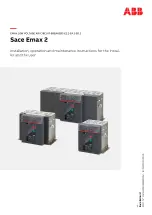
Communication-capable Circuit Breakers
The PROFIBUS COM15 Module and the BSS
The COM15 module enables the
WL Circuit Breaker to exchange
data via PROFIBUS to supervisory
systems and PROFIBUS masters.
The COM15 module retrieves
some of the key data on the
status of the circuit breaker
(circuit breaker open/closed,
closing spring charged, ready-
to-close, etc.) via the
Cubicle
BUS
from the BSS (breaker status
sensor). Both modules are,
therefore, offered together as
a PROFIBUS communication
package.
PROFIBUS Module COM15
The COM15 module for the WL
enables the circuit breaker to be
connected to the PROFIBUS-DP.
It supports the DP and DPV1
PROFIBUS protocols, which means
that it can communicate with two
masters simultaneously. This
makes it easier, for example, to
commission parameterization
and diagnostic tools and operator
control and monitoring systems
for the WL.
If required, control/write access to
the circuit breaker can be locked
using hardware and software to
prevent any switching operations
taking place via PROFIBUS
(manual or automatic operation)
or parameters from being changed.
All key events are assigned a time
stamp from the integrated clock
to enable operators to keep track
of alarms. This device clock can be
synchronized with the clock in the
automation system.
A temperature sensor integrated in
the COM15 module measures the
temperature surrounding the
breaker in the switchgear cubicle.
Three integrated microswitches
located in the COM15 module
are used to detect the position of
the circuit breaker (connect, test,
disconnect and not present) and
communicate via PROFIBUS. The
circuit breaker can be remotely
operated only in the test or
connect position.
Pin Configuration
The COM15 module is connected
to the auxiliary conductor plug-in
system at X7.
The electrical connections to the
circuit breaker and the
Cubicle
BUS
connection to the internal
Cubicle
BUS
modules (ETU, BSS,
metering function, etc.) are defined
in Section 9 of the Operator's Manual
and the individual instruction sheets.
Interposing relays must be used if
the opening and closing solenoids
are designed for voltages other than
24V DC.
Terminals X9.1 and X9.2 must be
used if the second shunt trip rather
than the first shunt trip is used to
open the circuit breaker via
communication.
The unassigned user output can
be used as required and must be
connected in the same way as a
coupling device (see Graphic 2-4).
It can be used, for example, to reset
the trip indicator if the remote reset
option has been installed. As with
Open and Close, only voltages of up
to 24V DC are permitted (note the
polarity); coupling devices must be
used for higher voltages.
The communications line is
connected to the 9-pin interface on
the front of the COM15 module.
The
Cubicle
BUS
connection for a
RJ45 plug is located at the rear and
is used to connect the external
Cubicle
BUS
modules. If no external
Cubicle
BUS
module is connected,
the terminating resistor supplied
must be used as an RJ45 plug.
The unassigned user input can be
connected using a contact element
with the 24V DC from pin 1 to
transmit the status of the contact
element.
2/8
WL Circuit Breaker
Graphic 2-2
The text on the COM15 module shows the external pin
configuration for closing solenoid (Y1) and the shunt trips (F1,2) as well
as the PROFIBUS write protection function and the unassigned input/output.
WL PROFIBUS Communication and Electronic Accessories • July 2004






































